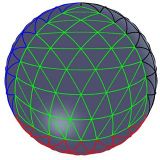OBD:M3GM: Difference between revisions
m (typo) |
m (changed family) |
||
| Line 1: | Line 1: | ||
{{OBD_File_Header | type=M3GM | prev=M3GA | next=Mtrl | name=Geometry | family= | {{OBD_File_Header | type=M3GM | prev=M3GA | next=Mtrl | name=Geometry | family=General | align=center}} | ||
| Line 80: | Line 80: | ||
{{OBD_File_Footer | type=M3GM | prev=M3GA | next=Mtrl | name=Geometry | family= | {{OBD_File_Footer | type=M3GM | prev=M3GA | next=Mtrl | name=Geometry | family=General | align=center}} | ||
{{OBD}} | {{OBD}} | ||
Revision as of 01:58, 8 December 2023
|
|

|
| Offset | Type | Raw Hex | Value | Description |
|---|---|---|---|---|
| 0x00 | res_id | 01 D7 00 00 | 215 | 00215-door_1_0.M3GM |
| 0x04 | lev_id | 01 00 00 06 | 3 | level 3 |
| 0x08 | int32 | 00 00 00 00 | 0 | runtime only |
| 0x0C | link | 01 DA 00 00 | 218 | link to 00218-.PNTA (vertex XYZs) |
| 0x10 | link | 01 F7 00 00 | 247 | link to 00247-.VCRA (vertex normals) |
| 0x14 | link | 01 F0 00 00 | 240 | link to 00240-.VCRA (face normals) |
| 0x18 | link | 01 ED 00 00 | 237 | link to 00237-.TXCA (vertex UVs) |
| 0x1C | link | 01 0C 01 00 | 268 | link to 00268-.IDXA (triangle strips) |
| 0x20 | link | 01 11 01 00 | 273 | link to 00273-.IDXA (face grouping by normal) |
| 0x24 | link | 01 D8 00 00 | 216 | link to 00216-.TXMP (texture) |
| 0x28 | link | 00 00 00 00 | unused | obsolete GMAN (geometry animation) link; never used in Oni |
| 0x2C | char[20] | AD DE | dead | unused |
- Vertices
- XYZ and UV coordinates are stored in parallel (same number of entries in PNTA and TXCA).
- Vertex normals
- The first VCRA stores the normals for every vertex (same entries as in PNTA and TXCA).
- Vertex normals are used by Gouraud shading (directional lighting).
- Face normals
- The second VCRA stores the normals for every face (groups defined by the second IDXA).
- Face normals are used for backface culling.
- Triangle strips
- The first IDXA lists the triangles as strips. The IDs are the ones in PNTA and IDXA.
- The start of a new strip is signaled by a high bit in the ID of its first vertex.
- Strips are more optimal for rendering, they are generated when authoring an M3GM.
- Face groupings
- The second IDXA groups the triangles into faces (oriented by the second VCRA).
- Geometry animation
- Geometry animation worked in a way similar to texture animation, by picking M3GMs from an array (GMAN) and displaying them at a specified frame rate, optionally with randomization.
- PS2 implementation
- PS2 M3GMs have the same data size as PC and Mac ones (0x24 bytes of actual data, 0x2C if counting the instance and level IDs), but the layout is different.
- Face normals aren't stored at all, and vertex normals aren't stored as VCRA either, therefore both VCRA and the second IDXA are simply missing, which frees up 12 bytes worth of space for data fields unique to the PS2 format.
- 8 of the 12 freed-up bytes are used by explicitly storing the number of vertices (i.e., the array size common to PNTA and TXCA) and the number of faces (same count as the 2nd VCRA on PC and Mac), as two int32's.
- The other 4 bytes are used to reference the compressed storage of vertex normals in the.raw file. This storage is very compact/lossy, using only 1 byte per normal (instead of 12 bytes per normal in the case of VCRA storage).
- An an example, consider M3GMaxes of level0_Final.
| Offset | Type | Raw Hex | Value | Description |
|---|---|---|---|---|
| 0x00 | res_id | 01 63 00 00 | 99 | 00099-axes.M3GM |
| 0x04 | lev_id | 01 00 00 00 | 0 | level 0 |
| 0x08 | int32 | 00 00 00 00 | 0 | runtime geometry flags (supposedly the same as for PC and Mac) |
| 0x0C | int32 | 60 00 00 00 | 96 | number of faces (same as in second VCRA on PC and Mac) |
| 0x10 | int32 | 01 64 00 00 | 100 | link to 00100-.PNTA (vertex XYZs) |
| 0x14 | link | 01 65 00 00 | 101 | link to 00101-.TXCA (vertex UVs) |
| 0x18 | link | 01 66 00 00 | 102 | link to 00102-.IDXA (triangle strips) |
| 0x1C | int32 | 6C 00 00 00 | 108 | number of vertices (same as in PNTA and TXCA); also size of .raw part in bytes |
| 0x20 | offset | A0 8E 01 00 | 0x00018EA0 | offset into the .raw file where the the 108 compressed vertex normals are stored:
2D 2D 2D 2D 2D 2D 2D 2D 2D 2D 2D 2D F8 F8 C2 55 40 40 10 D4 D4 09 C2 5F 6B 6B 6B 6B 6B 6B 6B 6B 6B 82 82 D9 16 E3 E3 00 EB EB 6D 6D 6D 6D 6D 6D 6D 6D 6D 6D AB AB EB 80 52 FC 95 30 30 EA EA EA EA EA A7 A7 24 EA EA EA EA 24 02 02 02 A7 A7 A7 A7 EF EA EA EA EA 02 02 02 02 24 24 24 24 F8 2D 2D 2D 2D A7 A7 A7 A7 EA EA EA EA 16 See below for a overview of the compression/decompression rule, i.e., how the 256 values of a compressed normal are mapped to the unit sphere. |
| 0x24 | link | 01 67 00 00 | 103 | texture link (to the empty 00103-_AXIS.TXMP; the actually relevant 00104-_axis.TXMP is orphaned) |
| 0x28 | link | 00 00 00 00 | unused | supposedly the same GMAN link (geometry animation) as for PC and Mac |
| 0x2C | char[20] | AD DE | dead | unused |
- OniBrowser being able to load PS2 M3GMs (a mystery of the modern times)
- Somehow OniBrowser is able to display M3GMs from PS2 instance files (except those with textures), even though all the links (PNТA, TXCA, IDXA) are in the wrong positions. Apparently, in the case of M3GM, OniBrowser reads in all the fields past 0x0C as a bunch of non-typed instance links, then identifies their types and populates the PNTA, VCRA, TXCA and IDXA references with the first encountered instance of the matching type.
- Compressed vertex normals
- It is somewhat uncommon to pack a normal vector into a single byte, but it turns out that there is a relatively straightforward way to subdivide the unit sphere into 256 sectors. One starts by splitting the sphere into four large quadrants (based on tetrahedral symmetry), and then each of the big "triangles" is subdivided into 4, then 16, then 64 smaller triangles, like the picture to the right. There is some distortion near the four poles, but other than that it's a valid way to pack normals if space is an issue (if packing to 2 bytes or more, then one would typically work in plain spherical coordinates instead, i.e. azimuth and elevation).
- There isn't much of a point in giving a detailed description of the mapping here, but the basic idea would be to use the lowest 64 values for the first quadrant, the next 64 values for the second quadrant, etc. In actuality the PS2 implementation uses 63 for the first quadrant, 62 for the second, 63 for the third, and 68 for the last - for whatever reason. Within a quadrant the distribution isn't entirely regular, either. To be documented later if at all.
- "Bad door lighting"
- When looking at the .raw part of the M3GM for some doors (level geometry), a striking observation is that there are only three distinct normal values (0xDE, 0x6A and 0x82), rather than the 6 normals that you'd expect for an axis-aligned box. Apparently half of those are bad, inward-pointing normals that no one ever bothered fixing. The regular VCRA normals for the same doors (on PC and Mac) are messed up in exactly the same way. Possibly this is related to the BSL variable door_pop_lighting ("uses bad door lighting").
| ONI BINARY DATA |
|---|
| M3GA << Other file types >> Mtrl |
| M3GM : Geometry |
| General file |

